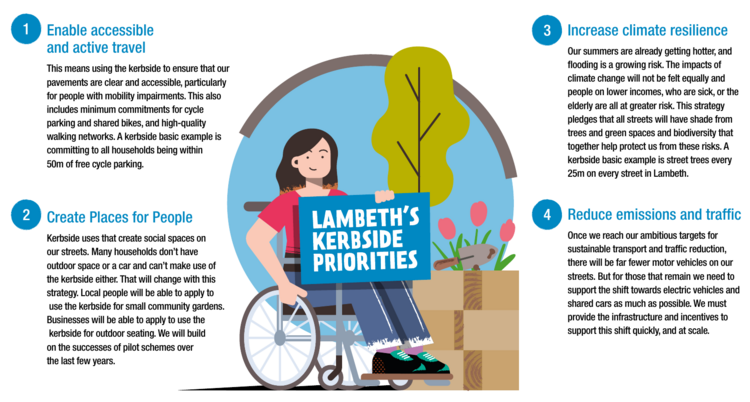In 1999, the council blocked cycling (in the middle of the day) on Cornmarket and the eastern end of Queen St; in 2017, with the redevelopment of the Westgate Centre, cycling was blocked at the same hours on Turn Again Lane; and then in 2022 cycling was blocked at the eastern end of St Michaels St. And now the county seems likely to ban cycling on a further 23 metres of Market St. This progressive removal of cycling routes has left no safe and inclusively accessible east-west cycling route through the city centre. High St and St Aldates have way too many buses, Pembroke St is unusable without a horrible dog-leg across St Aldates, and while George St is not so bad it still has too many buses, with turning movements.
Many people simply won't cycle on these routes, or let their children cycle on them. So if the councils are at all serious about enabling cycling, or about equity and inclusivity (and the Local Transport and Connectivity Plan has a goal of increasing cycling trips by 60% by 2030), then there has to be a fully accessible east-west route across the city centre. (I have previously written about the need to support inclusive cycling.) The most sensible way to achieve this is, in my opinion, to allow cycling at all times of day on Queen St and Cornmarket, but there are different options.
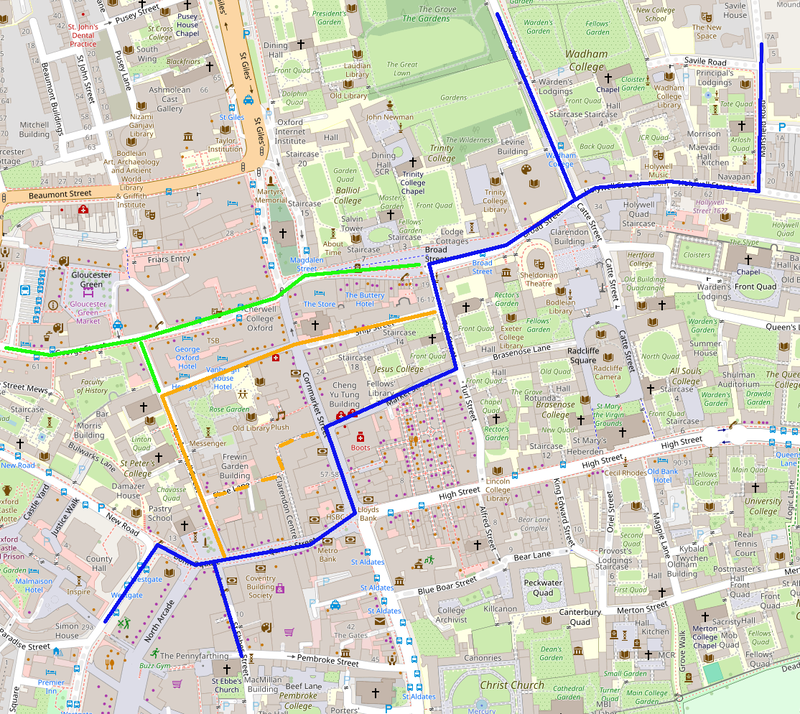
blue shows an accessible east-west cycling route; orange the alternative route using St Michaels St and Ship St; green a route on George St; and dashed orange a route through what was the Clarendon Centre
more
This is an excellent set of ideas. We support both the broader goals of the COMPF project and the list of specific ideas, though the latter will need to be fleshed out with details before we can see how they will actually work. There are also a few areas we would have liked to have seen included that weren't.
The opportunities for improvement are huge. The public realm in the city centre is of quite poor standard, making it relatively unattractive for residents or visitors: central Cambridge is significantly nicer, to make the obvious comparison, as are the centres of York, Bath, or even Birmingham. (Though to be fair, some of those cities are significantly less pleasant than Oxford just outside the centre.)
Walking around central Oxford can be quite unpleasant: narrow, cramped footways, awkward and hostile crossings where people are almost forced to cross on red, too much motor traffic (including high bus flows in some locations), and poor separation from cycling.
There is also poor provision for cycling: most notably in the absence of accessible east-west and north-south routes through the centre, and the lack of any kind of safe, coherent and consistent cycling infrastructure along Banbury and Woodstock Rds.
more
A scheme for High St should be included in the Central Oxford Movement and Place Framework. High St is a major pedestrian corridor, hosts a large number of shops, is a major bus corridor with some of the busiest bus stops in the city, and is a cycle route used by over three thousand people a day.
But High St has never been designed for this mix of uses: it still has pretty much the same layout it had before the bus gate was put in in 1999. It is poor for walking (the footways are too narrow and crossing the wide carriageway with buses blocking visibility can be a real challenge), poor to terrifying for cycling, and far from ideal for bus services, either for bus movement or for passenger boarding and alighting. And the cramped footways and poor visibility can make accessing - or even finding - the shops difficult.

road injuries on High St, 2014-2023
more
This was a response to a consultation on the Greenways. Please let me know of any errors or omissions. more
In 2018, Andrew Gilligan wrote "Despite the huge numbers of cyclists using them, Oxford’s main roads and junctions are still laid out almost entirely for the benefit of the motor vehicle". Sadly this remains true, and though a few stretches of road have more or less decent cycling provision along them, there is still not a single Oxford junction actually designed for walking and cycling, rather than having minimal pedestrian provision and ad hoc features to support cycling tacked on as an afterthought. But if we venture a little out of Oxford, there is now one junction whose design really does take walking and cycling seriously, and which could be shown to others as a model. That is the roundabout just south of Kidlington, where Frieze Way and Bicester Rd connect with Oxford Rd.
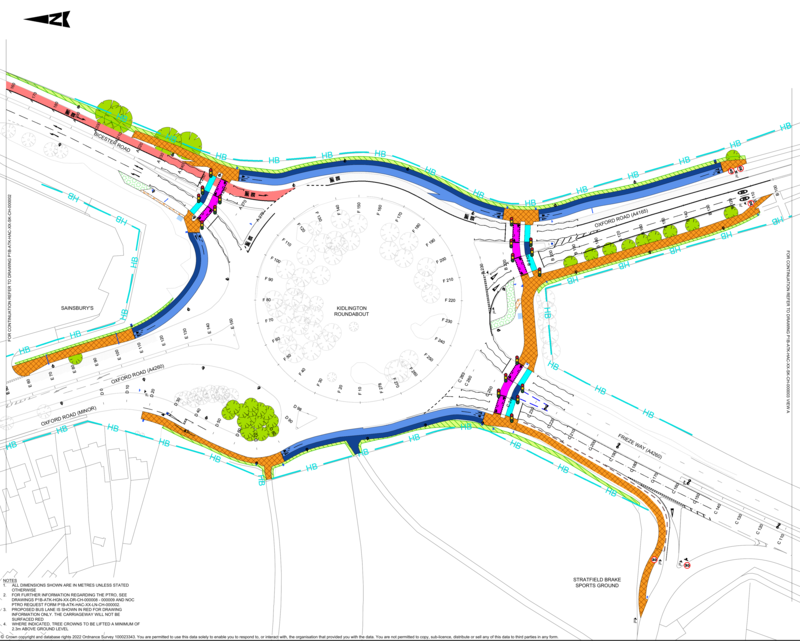
There is a consultation on removing the parking on Hollow Way to reduce congestion, with reducing bus delays as the main motivation.
"There are longstanding issues on Hollow Way, where its narrow width coupled with on-street parking create congestion and a safety risk as there is not sufficient space for vehicles to easily pass one another. This is a particular issue for local bus services who regularly use the route and report regular delays. The issue also leads to traffic congestion and makes it more difficult for residents and businesses on the road."
But this illustrates how moto-normative transport planning still is, even in Oxford. The only gains considered are congestion reduction and safety for vehicles, which are balanced against the loss of parking for residents and businesses.
There is no mention of walking, wheeling or cycling, or of Vision Zero; nor are the broader effects on the lives of people considered. There is no discussion of traffic speed, though one of the central concerns with removing the parking is that it will result in people driving faster. And there is no mention of air pollution or noise pollution, which the scheme is likely to make better in some locations and worse in others.
more
There have been concerns about road danger on Barton Fields Rd, the spine road that runs through the Barton Park development on the eastern outskirts of Oxford, in particular around the primary school. One driver ploughed into the cycle parking stands outside the school, another hit one of the buildings under construction on the other side of the street, and there are a lot of other incidents that don't show up in the official road injury record. (There are also concerns about road danger at the crossing of the A40; I have written about those elsewhere.)
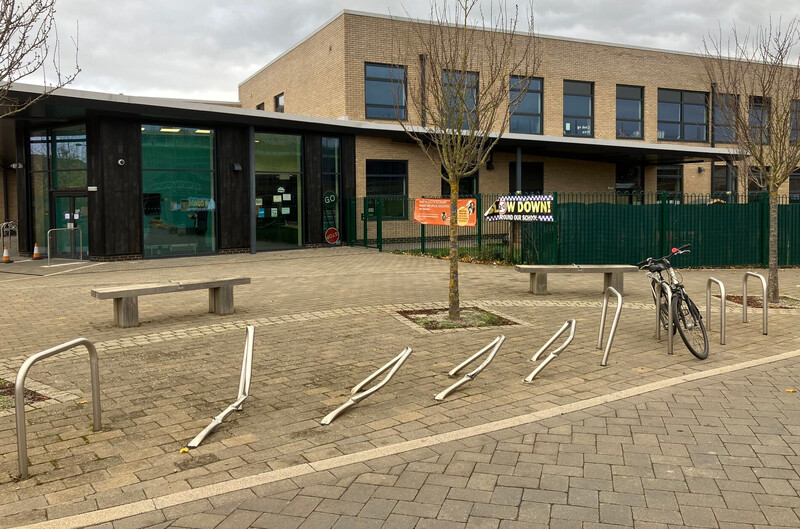
cycle parking stands outside Barton Park Primary School, bent over by being driven into
|
more
"The county should buy a unicorn and stable it on the Plain roundabout, where it will magically stop any collisions, alleviate all congestion, and make walking and cycling safe and accessible to all." This would probably make more sense than some of the transport proposals being bandied about - bus tunnels, removing cycling from main roads, etc. - but here I attempt to address some of the suggestions that seem sensible, but won't do what people want them to do.
Free public transport, segregated cycle tracks, School Streets schemes, traffic calming, Dutch style roundabouts, trams, and so forth are all potentially useful. But they only solve some problems, and in some cases require other measures to make them possible. They are not magically going to obviate the need for traffic removal and reduction - for low traffic neighbourhoods and measures such as traffic filters and the Zero Emission Zone. more
The legal changes to Broad St have been made permanent, but the current layout is clearly still temporary, in the sense that many of the features of the area no longer reflect its actual use. Most obviously, most of the existing kerbs are now redundant, or in the wrong place, and serve only as a trip hazard.
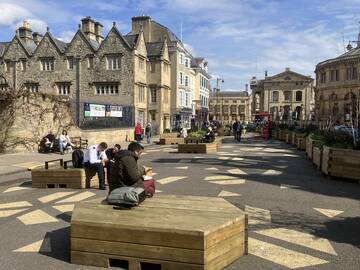
sitting around
A proper plan for Broad St needs to be part of a redesign of the entire area of the city centre north of High St and east of Cornmarket, as envisaged in the Oxford Preservation Trust's proposals twenty years ago, and any such plan will be dependent on funding which is not yet available. But there are possibilities in the management of vehicle access and parking for improvements that could plausibly be implemented in the shorter term. more
At the moment, footways in Oxfordshire fall into the cracks between different county teams. Parking, Road Agreements, Transport Development Control, Active Travel, Maintenance, and different Localities teams all implement or oversee schemes that affect footways, but no one has overall responsibility for them. A single county team should be given responsibility for footways, with a watching brief over all schemes that affect them. That could be a beefed up Active Travel team, or a Parking team with an expanded mandate. more
The Oxfordshire policy on 20mph speed limits says that to be eligible an area must "be within the extent of the built-up environment of the town or village where vulnerable road users and vehicles mix in a frequent and planned manner" and "be in an environment that explains and justifies a lower speed limit to the driver".
A small addition to this would I think make sense. There are sections of road which are not within a built-up area, but which are key walking or cycling links. They may link a village to a bus stop or a strategic cycling route, for example, or an outlying housing cluster (hamlet) to a village centre, or a school to a town centre. Where such sections of road are relatively short and lower speeds would make a significant difference, perhaps because there are no footways or cycling infrastructure, or because crossings are necessary, I think they should be included in the scope of the 20mph policy. more
This outlines a plan for a direct, coherent east-west foot-cycle route across Oxford's city centre. That would run from the railway station across the north of Frideswide Square, along Hythe Bridge St, George St, Broad St, Holywell St, and Longwall St, ending at Magdalen Bridge.
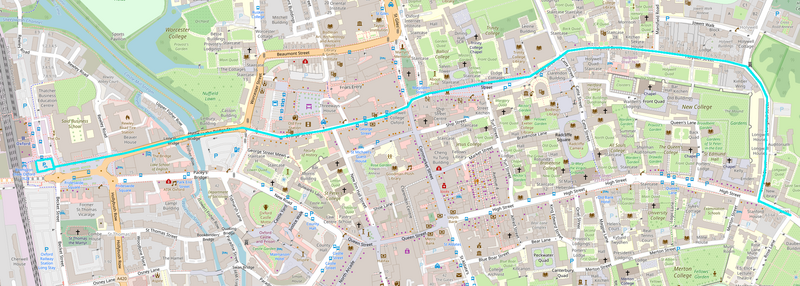 more
more
Fixing all the problems with footways and pedestrian infrastructure across Oxfordshire would involve a huge and expensive program of works, which the county doesn't have the resources for. But we need to stop making things worse — current procedures and processes for new transport schemes and developments and ongoing maintenance are progressively destroying our footways. more
Despite the research, I had always downplayed the psychological and social gains from traffic reduction, thinking of them as secondary to health improvements from increased physical activity - and perhaps as a bit "soft" and hard to measure. But my experience with the East Oxford Low Traffic Neighbourhoods has made me rethink this. more
Deaths and serious injuries — the target of Vision Zero — are just the tip of a much larger iceberg of road danger harm. In addition to the 20 road traffic fatalities and 450 serious injuries in Oxford over the last decade, there were 2800 reported slight injuries (all of those from the STATS19 police database) and (for cycling injuries, across Oxfordshire) ten times as many hospital admissions and attendances (this includes non-collision injuries which are rarely reported to the police). And there will be many minor injuries and collisions which are neither reported to the police nor result in hospital presentations. (Following Ling Felce's death at the Plain, I heard several people make comments like "Oh yes, I've been knocked off my bike twice at the Plain" and "No, I didn't report it either time.") There are even more near-misses and other incidents perceived as threatening. more
Oxford's Lye Valley area has poor walking and cycling connectivity, making it one of the more car dependent areas inside the ring-road (looking at 2011 census commute data). Two key routes could be upgraded to improve this, to the west across Lye Valley to the Churchill Hospital and to the south west over the golf course.
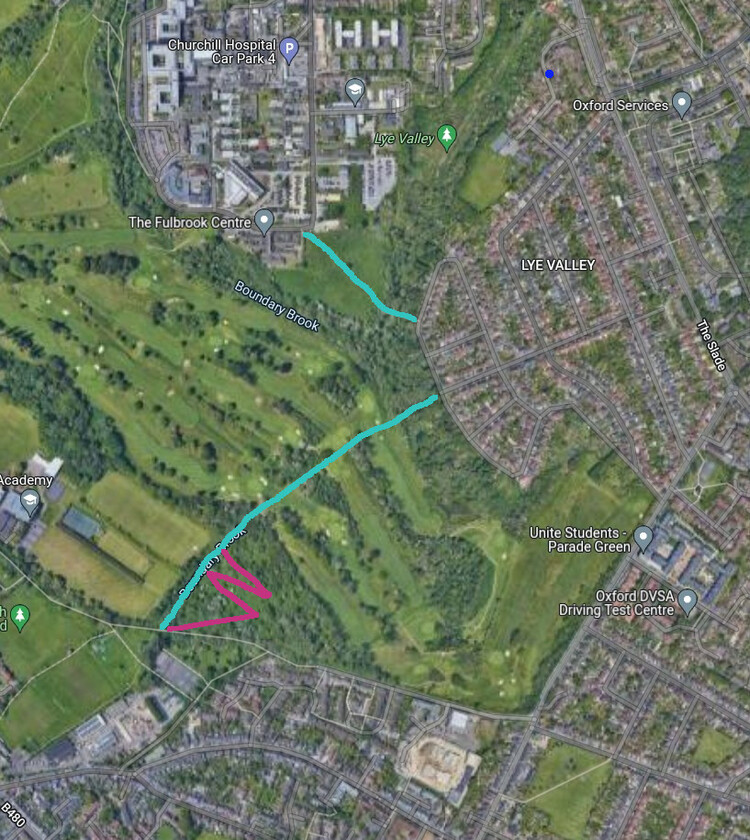
1) Put a proper foot-cycle track, with a bridge, across Lye Brook to the Churchill Hospital. 2) Upgrade the track across the golf course to Barracks Lane to an all-weather foot-cycle track, with a bridge across Boundary Brook to connect to Lye valley and potentially with zig-zags on the descent to Barracks Lane. This would require a legal change from a footpath to a bridleway. The likely form of any track would be a 3 metre wide shared path, with porous surfacing and embedded stud lighting, along the lines of the ones being put in across parks and fields elsewhere (e.g. across King Georges Field).) more
I think consideration should be given to turning off the signals at the northern end of Cornmarket and having that junction operate like the Holywell junction at the other end of Broad St.
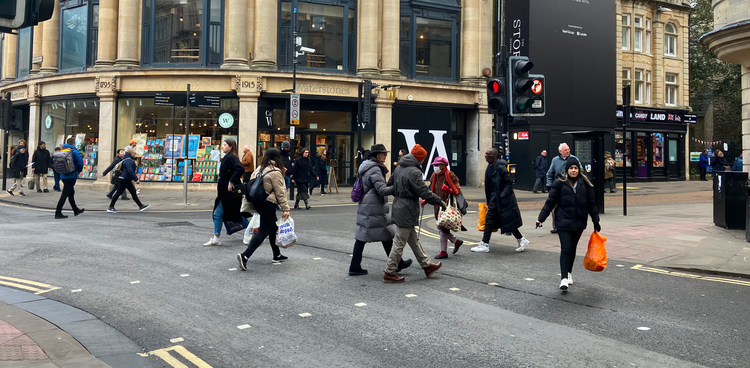
I walk and cycle through this junction regularly, and there's pretty much always:
- a stream of pedestrians crossing on red across George St, as in the photo above - if they didn't they'd pile up and block the footways;
- pedestrians crossing haphazardly across the unsignalled Magdalen St West and Broad St arms, sometimes getting caught out mid-crossing by signal changes;
- mopeds and cycles going through red lights or using the wrong side of the road to turn from Broad St into Magdalen St West; and
- significant periods when buses and taxis and cycles are waiting even though the junction is clear.
more
Lambeth recently released its Kerbside Strategy. That proposes a reallocation of kerbside space towards active travel, place making, climate resilience, and traffic reduction (94% of Lambeth's kerbside is currently devoted to parking or parking restrictions). [Update: Hounslow adopted a kerbside strategy and parking strategy in July 2024.]
more
Wherever possible, space for cycle or scooter parking should be taken from car parking space or spare carriageway space, not from footways or space for pedestrians. Pedestrians are at the very top of the transport hierarchy and private cars at the very bottom.
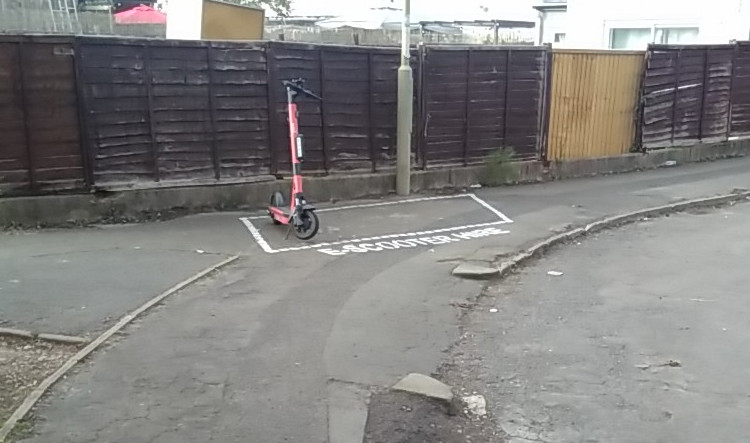 more
more
While the county should continue to support schemes for schools that request them, having that as the only way for schemes to happen will limit the effectiveness of the program. The county should proactively plan School Streets schemes at those locations where they will have the most effect. more










